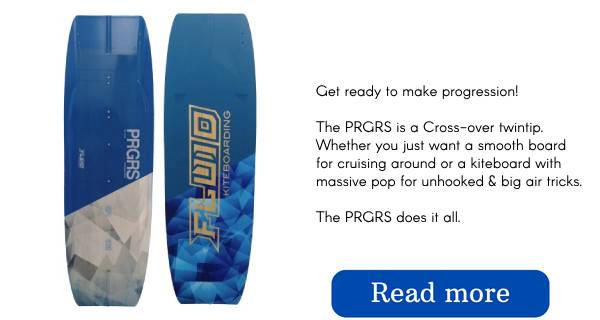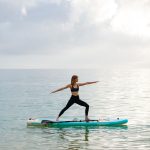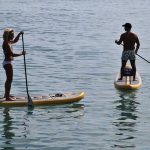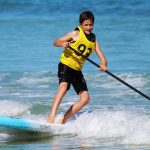It is clear that a board that is extremely steady is the top choice for those just beginning paddleboarding to pick up the essentials without the disadvantage of inexperience.
Boards with adequate stability enable first-timers to rise to their feet and start paddling within a few minutes. They will be able to learn the standard strokes and abilities by the time they finish their initial SUP class…
Stability Paddle Boards Are Not Just For Beginners
Even if you are new to the SUP world, you may still want to consider having a stability SUP board as there are plenty of reasons to own one.
You may weigh more than is typical and feel uncertain about your ability to stay steady.
It may be beneficial to possess the skill of navigating through choppy waters and boat wakes while remaining dry and out of the water.
You might be considering utilizing your board for doing yoga, fishing, bringing your kid or pet aboard. You may even consider taking a whitewater trip and dealing with rapids, which will require more balance than a general all around board.
What Makes One SUP Board More Stable Than Others?
It is generally acknowledged that the balance of a board is related to how wide it is, but this doesn’t explain the whole picture. It is a fact that wider SUPs, provided all else is even, are usually more stable than narrower boards.
However, other components factor in when it comes to determining the steadiness of a SUP board that also offers good performance and an enjoyable paddle.
Two other aspects to consider in addition to the width of a board are its thickness and the outline of its shape.
Oftentimes, board thickness gets forgotten when it comes to board design, yet it has a profound effect on board equilibrium. This may be different than what is commonly assumed.
In the initial stages of creating paddle boards, all of them had a thickness of roughly 4 inches. At that point, the strength, stiffeness, and size were not enough for a lot of cyclists. Boards that were four inches thick had a tendency to bend a lot and even warp in the center when used by people that were heavy.
In order to address this situation, materials were utilized to make boards measuring 6 inches in thickness that were considerably firmer than 4-inch boards and possessed more capacity to uphold sturdier riders.
The industry transitioned to 6-inch boards as a collective based on the idea that thicker is always preferable.
Adding 2 inches to the existing board design of 4 inches increases the board’s center of gravity, thus reducing stability which makes it feel less steady.
A six-inch board thickness may be advantageous for certain boards that need the additional thickness to improve its performance capabilities. We understand that this level of thickness can be necessary for the overall shape, design, and purpose of the board.
For numerous Deck Riders, 6 inches of width is too much; Whereas, a board that is 5 inches wide offers an excellent combo of strength, firmness, size, and tactile sensation.
Aside from size, there are other aspects that dictate how stable a board is. For example, a board that is wider at the back portion will provide a more steady feeling while performing paddling movements since a larger part of positioning will happen near the back of the board.
A board with an expanded front will have a higher level of stability when someone or an animal is on it. Generally, boards with a milder sidecut will be steadier than boards that have sharp edges and are slim at the front or back.
Fin Set Up
Fins enhance the balance of the board by giving it some resistance to rocking, yet its dimensions, thickness, and overall shape influence stability far more.
The fins of a surfboard have much to do with its performance in different aquatic settings.
Boards that are inexpensive generally have a fin system that has one fin that is specific to a particular board brand and can be taken out, with a pair of tiny, permanently affixed side fins. There are some drawbacks to this arrangement.
Initially, replacing the center fin of the board can be a tricky job since it can only be obtained from the board’s producer if it is destroyed or lost. If the center fin is not utilized, it is unlikely that the small side fins will offer enough grip to propel the board forward without it spinning loosely.
Moreover, the center fins on more affordable boards do not have the capacity to be adjusted frontward or backward within the fin box to alter the board’s performance.
Deck Pads Can Enhance Various Board Uses
The addition of a deck pad will not change the firmness of the board, however, it could influence its appropriateness for the different activities that can be carried out on a stable board. For flat water and fitness paddling, or for doing yoga on a paddle board, you may want a shallow and smooth deck pad with a crocodile skin or brushed texture. This will provide you with a reliable grip and will feel good against your feet.
For whitewater, surfing, and other rough water situations, a more profoundly scored diamond or square furrowed pattern will improve footing and help water to trickle off the board surface.
An extended deck pad that needs to be large enough to fit along three-quarters of the board’s total length is suggested if you are intending to do Stand Up Paddleboard Yoga or carrying a pooch on the board.
Boards with a flat strap handle and a removable neoprene hand grip are advantageous compared to bulky, permanently affixed handles. The lack of hand fatigue during carrying and the ability to flatten the handle makes them ideal for yoga and more intense paddling sessions in which a bulky handle wouldn’t provide enough space for footwork.
Inflatable vs. Hard Board For Stability
A blow-up paddle board, when filled with air to the advisable level of pressure, usually has more stability than a solid board with the exact same size.
The consistancy of an inflatable board’s thickness makes it more buoyant than a hardboard which usually thins out near the edges, nose, and tail.
Choosing A Board For Stability Doesn’t Mean Sacrificing Performance
Using a stability board can help you learn faster and enhance your confidence in the water, whilst also being a pleasurable experience and allowing you to do more than you would be able to do on a smaller board.
Activities such as whitewater rafting, yoga, fishing, taking your dog out in a kayak, and taking your children out on the water can all be more manageable on a vessel that is stable.
When deciding upon a good stable stand-up paddleboard, take into account the thickness of the board, the deck pad, and the fin system.
Ensure that they will let you do all kinds of activities on an especially secure SUP board.
The 4 Best Inflatable SUP Boards of 2023
Best Overall Inflatable SUP
Bluefin Cruise Carbon
Our top selection for inflatables SUPs is the Bluefin Cruise Carbon due to its robust carbon-strengthened design and superior all-round performance. The 12 foot long, 32-inch wide design of this vessel, along with the pointed nose and Flex Reduction System (FRS) give it an excellent gliding capability.
The FRS also gives it a terrific stability, even in choppy waters, making it a great platform for paddling. The Cruise Carbon has a kayak seat add-on as well as a paddle capable of transforming the board so it can be paddled like a kayak while sitting.
The pump that we evaluated with the highest level of capacity had two compartments and was excellent; the accompanying bag for carrying it is robust, with caster wheels and a pleasant amount of padding in the straps. In addition to these features, the product also comes
with a dual cargo securing system, handles for gripping on both the front and back, as well as a raised platform for stomping on the deck pad. The Cruise Carbon 12 is our top pick due to its superior construction, high-end components, and reliable results.
The Cruise Carbon 12 is a great, premium board, but it has a weighty cost tag and is a bit on the heavier side. Apart from the substantial and large board, features like the kayak seat and the convertible paddle blade add to the difficulty involved in fitting everything into the accompanying tote and making it quite the heavy load to transport.
While the combination SUP/kayak paddle was a creative concept, it ended up being too bendable for use in SUP mode on such a sturdy and sophisticated board. The Cruise Carbon’s brilliance easily cancels out any possible flaws.
Best High-Performance Buy
Bote Breeze Aero
Novice and experienced kayakers will be sure of themselves while they become better at handling various types of weather on this dependable and lightweight Bote Breeze Aero board. Giving superior products without giving up strength, the Bote has earned commendation for its all-round excellence and affordability.
This design includes a compartment at the front suitable for gear storage, handles situated in various places and D-rings on the side that can be employed for carrying, towing or tying. The majority of the deck is fitted with a soft, secure cushioning which is ideal for sitting, lounging, or performing Yoga poses.
The Breeze Aero has a weight of 20 pounds when it is fully inflated and can withstand a weight of up to 250 pounds. The bag is very adjustable and comfortable when worn. The affordability, portability, and entertainment that this board offers make it an excellent choice.
The Breeze Aero demonstrated itself to be rock-solid in turbulence and uncomplicated for paddlers of all capabilities to control. This board slips swiftly across swells and traverses placid water due to its gradually narrowed nose, extended middle fin, and height of the board.
This strong and lightweight board could be enhanced with detachable fins and a leash that comes with it. This board is a great choice for those looking for a cost-effective product that offers top-notch features, top-notch craftsmanship, and easy mobility.
Best Bang for the Buck
FunWater 11
Our testers were very pleased with how well the FunWater 11 performed and how reasonably priced it was. The board’s smooth long-distance shape, which comes with three fins, gives gliders decent speed and an even trajectory, and is sufficiently strong to attract novices and fearful canines.
Coming in at approximately 18 pounds, this item is one of the most lightweight boards we tested and its retail price is much more economical than any other board we looked into.
FunWater 11 is an excellent value, consisting of an efficient backpack, a top-notch adjusatable three-piece paddle, and accessorizing extras such as an ankle leash and a dry bag.
The FunWater 11 is bolstered with a convenient and strong midsection carrying band, however it is missing a front and back grip, which would make shifting it once it is augmented simpler.
This board is not as reliable as some of the others, particularly when there are rough waves. The advantages of the board outweigh the small disadvantages it has, making it a good value for its cost, and includes additional features.
In order to head out to the water inexpensively, all you need to bring is a life jacket or personal flotation device.
Best Inflatable Board for Touring
Red Paddle Co Voyager+ MSL
The Red Paddle Co Voyager+ MSL checks all the boxes in terms of quality, profile, and performance, so much so that it has scored highly across the board. It is, in our opinion, the top choice for touring.
This board may not be the ideal selection for those new to paddling or families looking for an all-purpose board, since it is specifically made for experienced users in search of superior glide and speed.
This fin design has a long and slim profile, giving it great performance in windless conditions so that you can cover a lot of ground. However, it also holds up well in gusty and choppy terrain.
The Voyager+ MSL is an elite surfboard, equipped with a FCS Connect fin and an RSS stiffening system that enhances the robustness of its edges, providing superior operation.
The cherry on top of this product is the included two-compartment, compatible with any system pump; this is undoubtedly one of the top-rated pumps in our review.




